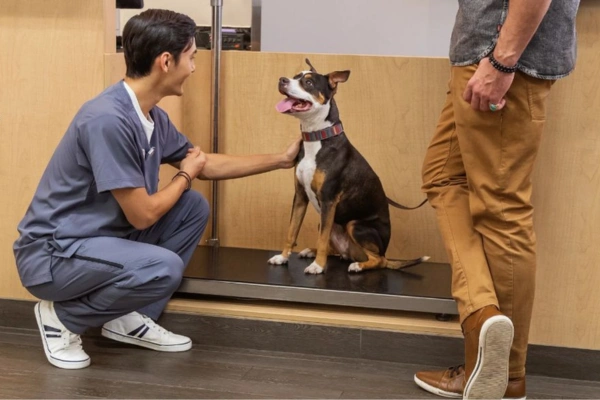How to Recognize and Treat Pet Anxiety
Just like humans, pets can experience anxiety. Changes in environment, unfamiliar people, loud noises, and other stressors can cause anxiety in animals. It’s important for pet owners to be able to recognize signs of anxiety and know how to treat it effectively. Left unmanaged, anxiety can impact a pet’s health and behavior, leading to issues like aggression, self-injury, and destructive behavior. In this guide, we’ll explore how to recognize signs of anxiety in pets, understand its causes, and go over various methods to help soothe and manage your pet’s anxiety.
Understanding Pet Anxiety: Causes and Types
Pet anxiety is often triggered by specific events or experiences that make pets feel threatened, uncomfortable, or distressed. Recognizing the underlying cause of anxiety can help you provide better support for your pet.
Separation Anxiety
This is one of the most common forms of anxiety in pets, especially in dogs. Pets with separation anxiety experience distress when they are left alone. This type of anxiety can lead to behaviors such as whining, howling, barking, destructive chewing, or attempting to escape.
Noise Anxiety
Loud noises, such as fireworks, thunderstorms, or even household appliances, can trigger anxiety in pets. Noise anxiety is particularly common in dogs, though other pets may also be affected. Pets with noise anxiety may tremble, hide, pace, or become clingy when exposed to loud sounds.
Social Anxiety
Social anxiety can occur in pets that are not well-socialized or have had limited exposure to other animals and people. Pets with social anxiety may act aggressively or become overly fearful around unfamiliar animals or people. They may try to escape, growl, or hide when in social situations.
Environmental Anxiety
This type of anxiety is triggered by changes in the pet’s environment. Moving to a new home, introducing new pets or people, or even rearranging furniture can cause environmental anxiety. Pets with this type of anxiety may pace, become withdrawn, or engage in destructive behaviors.
Generalized Anxiety
Some pets have a predisposition to anxiety due to genetics or past trauma. Generalized anxiety can lead to chronic fear and nervousness without any specific trigger. Pets with generalized anxiety may show signs of distress even in familiar environments.
Recognizing Signs of Anxiety in Pets
Being able to recognize anxiety symptoms in your pet is essential to providing them with the right support. Signs of anxiety can vary depending on the animal, the type of anxiety, and the severity.
- Pacing or restlessness: An anxious pet may move around continuously or appear unable to settle down.
- Excessive barking, meowing, or whining: Vocalizing can be a sign that your pet is feeling distressed.
- Destructive behavior: Pets with anxiety may chew, scratch, or destroy furniture, doors, or other household items.
- Panting and drooling: Heavy panting or drooling, especially in the absence of exercise or heat, may indicate anxiety.
- Shaking and trembling: If your pet is visibly shaking or trembling, they could be feeling scared or anxious.
- Attempts to escape or hide: Some pets may try to escape, hide, or seek small spaces where they feel safer.
- Changes in appetite or grooming: Anxiety can impact a pet’s appetite and grooming habits. Some pets may refuse to eat, while others may over-groom or pull out their fur.
It’s important to understand that these behaviors are often involuntary reactions to stress or fear. Avoid punishing or scolding your pet for displaying these behaviors, as it can worsen their anxiety.
Causes of Anxiety in Pets
Identifying the cause of anxiety can make it easier to address.
- Loud noises (e.g., fireworks, thunderstorms)
- New environments (e.g., moving to a new home)
- Lack of socialization during developmental stages
- Changes in family structure (e.g., new pet, baby, or family member)
- Past trauma or abuse
- Inconsistent routines
Some pets are naturally more prone to anxiety due to genetic factors, especially certain breeds of dogs and cats. Additionally, pets adopted from shelters or rescues may have experienced stressful or traumatic situations in the past that contribute to anxiety.
Treatment Options for Pet Anxiety
Once you recognize signs of anxiety in your pet, the next step is to take proactive measures to help them feel calm and secure. Treatment can range from behavioral modifications to environmental changes, and, in some cases, medical intervention.
Behavioral Modification and Desensitization
Behavioral modification techniques can help a pet overcome anxiety by gradually exposing them to the things that trigger their anxiety in a controlled way.
- Desensitization: Gradually exposing your pet to their triggers at a low intensity can help them build tolerance. For example, if your pet is afraid of thunderstorms, you could play a low-volume recording of thunder sounds and gradually increase the volume as they become more comfortable.
- Counter-Conditioning: This involves associating a positive experience with the anxiety trigger. If your pet fears car rides, for example, you might start by rewarding them with treats and praise each time they get into the car, creating a positive association.
Maintain a Routine
Predictable schedules can help reduce anxiety, particularly for pets prone to separation anxiety.
Create a Safe Space
Creating a designated “safe space” can help pets feel secure. This area should be a quiet, comfortable spot where they can retreat when they feel anxious. Include their favorite bed, toys, and blankets, and make sure it’s away from loud noises or disturbances. For noise-anxious pets, white noise machines can help muffle outside sounds.
Exercise and Mental Stimulation
Exercise is essential for keeping pets healthy and can be a great way to reduce anxiety. Physical activity releases endorphins, which have a calming effect on pets. Engage in daily exercise, whether it’s a walk, fetch, or interactive play, to keep your pet stimulated and reduce anxious energy.
Therapies and Products for Managing Pet Anxiety
In addition to lifestyle changes, several products and therapeutic options can help manage anxiety in pets.
Calming Products
There are various pet products designed to help alleviate anxiety, including:
- ThunderShirts: These specially designed jackets apply gentle, constant pressure, which can have a calming effect similar to swaddling a baby.
- Calming Sprays and Diffusers: Products that release calming pheromones, like Adaptil for dogs and Feliway for cats, can help reduce stress by mimicking natural soothing signals.
- Natural Supplements: Some pets respond well to supplements such as CBD oil, chamomile, or valerian root.
Prescription Medications
In severe cases, a veterinarian may prescribe anti-anxiety medication. Medications such as selective serotonin reuptake inhibitors (SSRIs) or benzodiazepines can help manage anxiety symptoms. Prescription medication should be used under strict veterinary guidance, as it may have side effects or require specific dosages.
Professional Training and Therapy
In some cases, working with a professional animal behaviorist or trainer can make a significant difference. A behaviorist can help identify the root causes of your pet’s anxiety and develop a treatment plan that includes desensitization exercises, training techniques, and possibly specialized equipment.
Caring for an Anxious Pet During Specific Situations
Certain events and scenarios are known to trigger anxiety in pets. By preparing in advance, you can help reduce stress for your pet during these situations.
Fireworks and Thunderstorms
Many pets fear the loud noises associated with fireworks and thunderstorms. To help, create a quiet environment during these events. Close windows and curtains to muffle sound, play calming music, and stay with your pet for reassurance if possible.
Vet Visits and Grooming Appointments
If vet visits cause anxiety, try to make the experience more pleasant by bringing along your pet’s favorite treats or toys. For grooming, you might consider shorter, more frequent visits to build familiarity. If your pet’s anxiety is severe, look for vets or groomers specializing in handling anxious animals.
Moving to a New Home
Moving can be a big stressor for pets. Prepare a safe area in your new home with familiar items to help your pet adjust. Gradually introduce them to different parts of the home and keep your routines as consistent as possible.
Conclusion: Supporting Your Anxious Pet
Helping a pet manage anxiety requires patience, understanding, and consistency. By recognizing the symptoms and implementing strategies to reduce stress, you can significantly improve your pet’s quality of life. Remember, every pet is unique—what works for one may not work for another. Stay attentive to your pet’s needs, consult with professionals when needed, and be patient as you work through the process.







